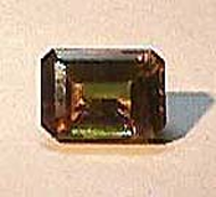The Story of Idocrase Gemstones
 Consumer Information
Consumer Information
What color is it?: Primarily a green color that will resemble jade. In fact idocrase is one stone that is sometimes mistaken for jade by jewelers and consumers alike. In a very rare form it occurs in a transparent variety that can be faceted. This is shown above with the brown/green color with strong color transmission in both.
What is the story behind this gemstone?: The opaque green variety of this gemstone was first discovered on Mount Vesuvius and is therefore sometimes called vesuvianite. But it is also found in its various forms in other parts of the world since its original discovery and is called idocrase.
Can I wear it everyday?: Yes, but better in earrings and necklaces. The hardness is a bit low for a lot of wear and tear in a ring.
Is it expensive?: Not really. About the same a as a nice pink tourmaline. But be prepared to pay a premium for a larger stone.
Is it a birthstone?: Not to the people who were in Pompeii….just the opposite!
What do I need to know before going shopping?: Be prepared to wait. Idocrase is available but will probably not be found in your local retail jewelry store. So you will need to contact a well established independent retail jeweler with a well trained gemologist on staff who can find you a selection of idocrase.
General Information
Source: Mount Vesuvius, US, Russia, Canada and others
Chemical: Aluminum calcium silicate (the chemical is as long as this page)
Formation: In primary igneous rocks
Crystal System: Tetragonal
Unusual Properties: Unusual coloring

